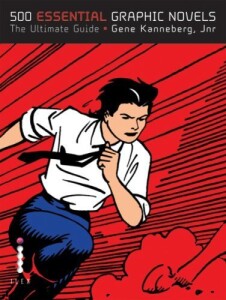 My, that was fun! I sat down earlier this afternoon with a notepad and pen in hand to make notes about 500 Essential Graphic Novels for review. Bad mistake, a really bad mistake. Why so, you ask? Because after hours and hours of really fun reading and some very extensive note noting, I now have a very long list of cool sounding graphic novels that will put a serious dent in my wallet. As the Collins Design press release said, ‘500 Essential Graphic Novels is an all-in-one guide to this exciting form of visual literature … The first of its kind, this book focuses on each graphic novel separately, honing in on art technique, style and prose.’ Oh, how true that is!
My, that was fun! I sat down earlier this afternoon with a notepad and pen in hand to make notes about 500 Essential Graphic Novels for review. Bad mistake, a really bad mistake. Why so, you ask? Because after hours and hours of really fun reading and some very extensive note noting, I now have a very long list of cool sounding graphic novels that will put a serious dent in my wallet. As the Collins Design press release said, ‘500 Essential Graphic Novels is an all-in-one guide to this exciting form of visual literature … The first of its kind, this book focuses on each graphic novel separately, honing in on art technique, style and prose.’ Oh, how true that is!
I consider myself reasonably well versed in this genre, having read – to name but a few – Authority, Books of Magic, B.P.R.D., Cairo, Fables, Gotham Central, Grimjack, Hellblazer, Hellboy, much of the current Justice League saga, League of Extraordinary Gentlemen, Mr. Majestic, Planetary, some S.H.I.E.L.D., Stormwatch, Sandman, Shadowpact, Swamp Thing, The Spirit, Tomb Raider, Transmetropolitan, Welcome to Tranquility, WildCATs, and more than a bit of the various X-Men series that have been done to date. I have started, but didn’t finish, some acclaimed series such as Lost Girls and Witchblade because my … oh, never mind why.
Have I talked you about what I call popcorn reading? Popcorn reading is anything which, in spite of any merit it might have otherwise, is best approached as entertainment. George R. R. Martin’s A Song of Ice and Fire series is perfect popcorn reading (several winters’ worth), as is any other serial fiction that is sufficiently long in duration, such as the Harry Potter series. Now apply that concept to graphic novels and consider my list above for what I’m generally looking for – lengthy series with an ongoing plot line and interesting characters. Oh, and better than decent art.
So can I say 500 Essential Graphic Novels will help assist me – or you, for that matter – with finding new series? Quite well I’d say, given that it covers more than three hundred fifty authors, four hundred artists, and yes, five hundred graphic novels. And as Collins Design notes on their Web site,’The first of its kind, this book focuses on each graphic novel separately, honing in on art technique, style and prose, plus an age rating system so parents will know what is suitable for their children. Chapters are divided by genre, complete with individual plot synopses and star-scaled reviews for each book, providing the reader with a concise and balanced understanding of today’s best graphic novels.’ Well, it’s not quite the first of its kind, as The Vertigo Encyclopedia, released earlier this year, is a far better source for all things Vertigo, but this may well be the first general look at graphic novels.
That the author’s definition of a graphic novel is quite broad is not surprising, given that graphic novels are a global pop culture phenomenon and have been so for decades. Kannenberg even includes trade paperback collections of comics, such as Hellboy, a Dark horse series, and Planetary and Transmetropolitan, which are Vertigo titles. Using what I liked as my own internal Pandora, I found a number of series worth checking out starting with Rex Mundi, a alternative Paris where magic exists; Starman: Sins of the Father and even a Maurice Sendak endeavor worth checking out.
OK, you can either read it cover to cover like I did (not recommended as it is a lot of information) or pick a section and see what looks interesting. I recommend it to anyone who reads graphic novels on a regular basis, provided you are not a comics geek who says that all comics must come from either the DC or Marvel universes. If you are not a comics geek, go get it now. It’s that useful, and fun to boot!
(Collins Design, 2008)
